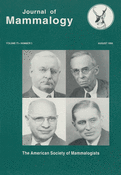-
Views
-
Cite
Cite
Peter E. Komers, François Messier, Peter F. Flood, Cormack C. Gates, Reproductive Behavior of Male Wood Bison in Relation to Progesterone Level in Females, Journal of Mammalogy, Volume 75, Issue 3, 25 August 1994, Pages 757–765, https://doi.org/10.2307/1382527
Close - Share Icon Share
Abstract
In mammals, estrus commonly is identified by the behavior of males. However, the reliability of this indicator may vary with age or experience of males. We monitored fecal-progesterone levels in female wood bison (Bison bison athabascae) that were tended. Males tended females more often when females were close to estrus (fecal-progesterone levels <1 µg/g feces). Subadult males also tended females that were clearly not in estrus (progesterone levels >1 µg/g feces). In contrast, in an experimental population from which we removed mature males, subadults tended females in estrus longer than those not in estrus. Our results suggest that although tending behavior of males is a reliable indicator of the occurrence of an estrous cycle, the behavior of only dominant individuals is meaningful. Subadult males often tend anestrous females because young males are excluded from breeding by the more dominant, mature males, not because of a lack of experience. When investigating the relationship between male behavior and the female's ability to produce young, as determined by subsequent births, we found that lactating females were more likely to ovulate than nonlactating females; but, among ovulation females, lactating and nonlactating females did not differ in their probability of producing young. This finding suggests that reproductive status of a female affects mostly ovulation, not conception. Accordingly, males did not prefer to tend ovulating females of either reproductive status.





